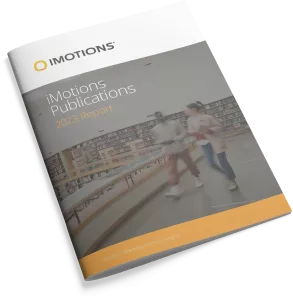-
Acceptance, Usability, and Emotions- An Extension of the UTAUT Designed for AI Virtual Assistants in the Context of Housing Modernization
The integration of AI virtual assistants (AIVAs) into daily life raises critical questions about acceptance, usability, and emotional reactions. This paper explores these constructs within the context of the German state-funded KIMM project, which investigates the use of AIVAs to support the modernization of rental housing stock. To better understand users’ interactions with AIVAs, we […] -
Optimizing sound alerts for traveler information systems: Insights from a driving simulator and eye tracking study
Traveler information apps provide drivers with timely alerts about crashes, work zones, and road closures, using accurate, agency-reported data to enhance safety. This study evaluates the effectiveness of different types of road incident alerts in enhancing driver responses using a driving simulator, eye-tracking glasses, and a questionnaire. This study assesses driver reaction and perception behavior […] -
Investigating Cognitive Strategies in a Mental Rotation Task using Eye Tracking Heat Maps
This research explores the use of heat maps derived from eye-tracking data to identify cognitive strategies in mental rotationtasks. Traditional methods like eye-tracking metrics and interviewshave limitations in capturing the full spectrum of strategy use. Wepropose heat maps as a novel methodology to bridge the gapbetween behavioral outputs and cognitive processes. Ourpreliminary findings demonstrate distinct […] -
Similar Facial Expression Responses to Advertising Observed Across the Globe: Evidence for Universal Facial Expressions in Response to Advertising
Effective measurement of audiences’ emotional responses has become a key need in advertising and content research. Analysis of facial responses has become a widespread tool to do so. However, there has been doubt expressed by some authors about the degree to which facial expressions are universal signals of emotional state. Most of the literature exploring […] -
A multi-modal investigation of retrospective emotions during a programming task
Literature underscores the important role of emotions in education, especially in challenging fields like programming. Emotions such as pride, shame, relief, and disappointment are often triggered after the task; hence, they are essential as they require students’ reflection on performance and influence future decisions. Yet, these emotions remain underexplored in educational contexts. This study investigates […] -
Eye-Tracking in Digital Pathology: A Vendor-Agnostic Platform for Standardized and Reproducible Eye-Tracking Studies
Eye-tracking technology has been increasingly utilized in various medical domains, yet its adoption in pathology remains limited. The lack of standardized methodologies and the complexity of analyzing whole-slide images pose significant challenges for applying eye-tracking in this domain. Existing studies often rely on proprietary and heterogeneous software solutions, reducing reproducibility and comparability of results across […] -
Emotion Detection on User Front-Facing App Interfaces for Enhanced Schedule Optimization: A Machine Learning Approach
Human-Computer Interaction (HCI) has evolved significantly to incorporate emotion recognition capabilities, creating unprecedented opportunities for adaptive and personalized user experiences. This paper explores the integration of emotion detection into calendar applications, enabling user interfaces to dynamically respond to users’ emotional states and stress levels, thereby enhancing both productivity and engagement. We present and evaluate two […] -
Urban façades and human stress: evaluating façades’ texture and layout
The variety of surfaces in urban environments is crucial for understanding human experiences in cities. Surfaces can influence navigation and emotional responses, particularly regarding specific façade characteristics. This study examined how spatial variables of façades-roughness, materiality, solidity-affect emotional stress and the human experience of places. An experiment using iMotions software and selected images of urban […] -
Can Heuristic Cues Improve Voluntary Carbon Offsetting Message Effectiveness?
Encouraging air travelers’ participation in voluntary carbon offsetting (VCO) remains challenging. Drawing on dual-process and social influence theories, this study investigates whether heuristic cues can optimize message design for online carbon offsetting. Through sequentially designed randomized national surveys and psychophysiological experiments, results revealed that messages leveraging primacy-recency, anchoring, and foot-in-the-door techniques are most effective in increasing carbon offsetting […] -
Leveling the Playing Field: Amplifying Rural Student Voices in Game-Based Learning Design with a Rural User Experience (RUX) Kit
This paper introduces the Rural User Experience (RUX) initiative, developed to assess and address the unique challenges faced by rural users in educational technology testing, particularly for game-based learning applications. By piloting a RUX kit and its associated activities in rural Missouri, this initiative aims to minimize sampling bias in user experience (UX) testing, especially […]
Research Report 2024
In-depth look at the scientific landscape as powered by iMotions software, showcasing groundbreaking research and the impact of our tools in various scientific and industrial fields.

iMotions Science Resources
Looking for white papers, validation reports or research show casing iMotions Multimodal capabilities?
Share Your Research

850+ universities worldwide with an iMotions human behavior lab
73 of the top 100 highest ranked universities
710+ published research papers using iMotions
iMotions is used for some of the most interesting human behavior research studies carried out by top researchers around the world. Contact us to have your publication featured here.
The authors of these publications have used iMotions as a software tool within their research.
“Software should be cited on the same basis as any other research product such as a paper or a book; that is, authors should cite the appropriate set of software products just as they cite the appropriate set of papers” (Katz et al., 2020).
We therefore encourage you to cite the use of iMotions where appropriate.
How to cite iMotions
APA
iMotions (10), iMotions A/S, Copenhagen, Denmark, (2024).
Note: adjust the version and year where relevant.
5 Most Popular Blogs
Publications
Read publications made possible with iMotions
Blog
Get inspired and learn more from our expert content writers
Newsletter
A monthly close up of latest product and research news


